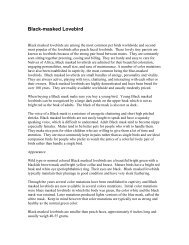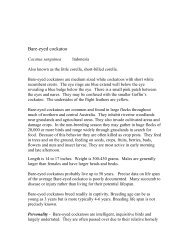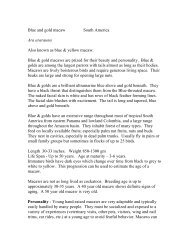Red-fronted macaw South America Ara rubrogeneys ... - Susan Clubb
Red-fronted macaw South America Ara rubrogeneys ... - Susan Clubb
Red-fronted macaw South America Ara rubrogeneys ... - Susan Clubb
Create successful ePaper yourself
Turn your PDF publications into a flip-book with our unique Google optimized e-Paper software.
<strong>Red</strong>-<strong>fronted</strong> <strong>macaw</strong> <strong>South</strong> <strong>America</strong><br />
<strong>Ara</strong> <strong>rubrogeneys</strong><br />
<strong>Red</strong>-<strong>fronted</strong> <strong>macaw</strong>s are medium sized green <strong>macaw</strong>s. <strong>Red</strong>-<strong>fronted</strong> <strong>macaw</strong>s<br />
are similar in color to Military <strong>macaw</strong>s but have red-orange crown, forehead<br />
and ear patches. The naked facial skin is rather small, white and has rows of<br />
black feather forming lines. The large shoulder patch is orange-red. The tail<br />
is long and tapered, and is olive tipped in blue. <strong>Red</strong> <strong>fronted</strong> <strong>macaw</strong>s are<br />
lively boisterous birds and require generous living space.<br />
<strong>Red</strong>-<strong>fronted</strong> <strong>macaw</strong>s have a tiny range on the eastern Andean slope of<br />
southern Bolivia. They inhabit arid forest and scrub land where food sources<br />
are limited. They feed on locally available fruits; especially palm nut fruits,<br />
seeds, nuts and buds as well as cacti. They often raid crops of corn or<br />
peanuts.<br />
Length 24 inches. Weight 450-550 gm<br />
Life Span – Unknown but probably up to 40 years. Age at maturity – 2-5<br />
years. Immature birds have dark eyes, which change over time from black<br />
to the orange eyes of adults.<br />
Personality - Young hand-raised <strong>macaw</strong>s are very adaptable and typically<br />
easily handled by many people. They must be socialized and exposed to a<br />
variety of experiences (veterinary visits, other pets, visitors, wing and nail<br />
trims, car rides, etc.) at a young age to avoid fearful behavior. Macaws can<br />
make excellent pets, although some have a tendency to become nippy.<br />
Macaws can be very loud as well as destructive. While some speak, most<br />
<strong>macaw</strong>s have limited ability to mimic.<br />
<strong>Red</strong>-<strong>fronted</strong> <strong>macaw</strong>s are very inquisitive, mischievous and animated. While<br />
they don’t enjoy handling as much as a blue & gold, they are delightful pets<br />
and aviary subjects because of their outgoing personalities.<br />
Activities - Macaws are playful and love to chew. They should always be<br />
provided with toys, especially wooden blocks that can be chewed, and<br />
branches from non-toxic trees. In order to ensure safety companion <strong>macaw</strong>s<br />
should not be allowed unsupervised freedom in the home as they often
encounter toxins or dangerous items. Young <strong>macaw</strong>s should be socialized to<br />
many people and exposed to a variety of situations such as new cages, toys,<br />
visits to the veterinarian, handling by friends, wing and nail clips, etc. to<br />
avoid fear of novel situations.<br />
Dietary needs - All <strong>macaw</strong>s need plenty of energy for good health. Many<br />
of their natural foods, especially palm nuts are rich in oils, and calories.<br />
Macaws should be fed a formulated (pelleted or extruded diet) as a basis for<br />
good nutrition. The diet should be supplemented with fresh fruits and<br />
vegetables daily to add variety and psychological enrichment. Feed<br />
approximately ¼ cup Kaytee Exact. Also offer ¼ cup of fresh fruits and<br />
vegetables. Give 2-3 nuts as treats. Best nuts are walnuts, macadamia,<br />
pecans, almonds and filberts. If peanuts are fed they should be opened and<br />
checked for mold first. Small amounts of seed may also be given as treats<br />
especially as rewards for good behavior. Vitamin supplements are not<br />
needed for birds that are eating a formulated diet.<br />
<strong>Red</strong>-<strong>fronted</strong> <strong>macaw</strong>s are somewhat difficult to hand feed from a very early<br />
age. They require a high fat diet and do well with additional protein as well<br />
especially at a very young age. Kaytee Exact is a good choice. A small<br />
amount of peanut butter or ground sunflower seeds may be added to increase<br />
protein and fat levels.<br />
Identification - All companion and breeding birds should be individually<br />
identified to assist in recovery if lost and assist in maintenance of medical<br />
and genealogical records. Many breeders apply closed legs bands when<br />
chicks are young. While they present a slight risk of entrapment closed<br />
bands are preferable to no identification, especially for breeding birds.<br />
Microchips, which can be implanted into the muscle or under the skin, are a<br />
reliable means of identification but require electronic readers to verify<br />
identification. Tattoos may be used but often fade or become illegible with<br />
time. Footprints may have some application in identification.<br />
Grooming - Routine bathing or showering is vital to maintaining good<br />
plumage and skin condition. Birds can be misted and allowed to dry in a<br />
warm room or in the sun, or dried with a blow drier. An ideal way to bathe<br />
<strong>macaw</strong>s is to put them in a cage outside, sprinkle them with the hose, and<br />
allow them to dry in the sun. Macaws are strong fliers. Most of the primary
flight feathers (10 feathers closest to the tip of the wing) should be clipped to<br />
prevent flight. Clip only enough so the bird will glide to the floor.<br />
Sexing - Macaw species show no obvious sexual dimorphism (visual<br />
difference between the species) therefore endoscopic examination (Surgical<br />
sexing) or laboratory sexing techniques are needed for accurate sex<br />
determination. Males are usually larger and have larger heads.<br />
Housing - Macaws are very active and should be provided the largest cage<br />
that space and budget allows. Macaws MUST be allowed space to fully<br />
extend their wings or muscle atrophy will occur rendering them unable to<br />
fly. As <strong>macaw</strong>s are strong chewers, durable cage construction is very<br />
important. Many are also adept at opening cage latches. Locks or escape<br />
proof latches may be necessary on cages.<br />
Ideally pet <strong>macaw</strong>s can also have a large cage outdoors for bathing and<br />
exercise.<br />
Breeding – <strong>Red</strong>-<strong>fronted</strong> <strong>macaw</strong>s breed fairly well in captivity. Breeding<br />
season is usually in spring and early summer, although some pairs will breed<br />
almost year round. Clutch size is usually 2-4 eggs but sometimes more.<br />
Incubation period is average 25 days (23-27 days). Some additional high<br />
fats seeds, like sunflower seed, should be added to the diet during the<br />
breeding season to stimulate reproduction. Inexperienced hand feeders<br />
should allow the parents to feed for the first few weeks.<br />
Nest Box – <strong>Red</strong>-<strong>fronted</strong> <strong>macaw</strong>s like vertical wooden box (approx. 12” x<br />
12” x 24”) or 16” x 16” x 24. The box could also be horizontally. Macaws<br />
should be provided with plentiful chewing material. Pine shavings make<br />
excellent nest box bedding.<br />
Cage size - Macaws should have adequate space to move freely between 2<br />
perches. Example of appropriate suspended cage size for red-<strong>fronted</strong><br />
<strong>macaw</strong>s is 4’ x 4’ x 8’. Cages should be suspended 3-4 feet above the<br />
ground.<br />
Cages for <strong>Red</strong>-<strong>fronted</strong> <strong>macaw</strong>s must be constructed of strong wire, although<br />
they are not as able to chew cages as the large <strong>macaw</strong>s. 14 gauge welded
wire, 1” x 1” works well for most pairs. When breeding <strong>macaw</strong>s, noise and<br />
proximity to neighbors must be considered.<br />
Mate aggression is uncommon in <strong>macaw</strong>s. Pair bonds are strong but not<br />
necessarily life long.<br />
Common diseases and disorders<br />
• Proventricular Dilatation Disease (Macaw wasting disease)<br />
• Feather picking<br />
• Chewing flight and tail feathers by juveniles<br />
• Oral and cloacal papillomas<br />
• Psittacosis (chlamydophila infection)<br />
• Bacterial, viral and fungal infections<br />
• Aspergillosis<br />
• Constricted toe syndrome, chicks<br />
• Beak malformations - chicks<br />
• Pancreatitis<br />
• Kidney Disease - gout<br />
• Toxicity, heavy metal poisoning<br />
• Clostridium infections<br />
Many common health problems of <strong>macaw</strong>s can be prevented by good diet,<br />
nutrition and routine health care. Routine veterinary examination (annually)<br />
can help you to keep your pet in excellent health and enhance your<br />
relationship with your bird.<br />
Conservation status – Endangered– <strong>Red</strong>-<strong>fronted</strong> <strong>macaw</strong>s are listed on<br />
Appendix I of the Convention on International Trade in Endangered Fauna<br />
and Flora due to their very limited range, habitat destruction and decline due<br />
to trade. International trade requires both import and export permits. <strong>Red</strong><strong>fronted</strong><br />
<strong>macaw</strong>s are uncommon in captivity but breed fairly well.






